

Catch Fish with
Mike Ladle
Information Page
SEA FISHING
For anyone unfamiliar with the site always check the FRESHWATER, SALTWATER and TACK-TICS pages. The Saltwater page now extends back as a record of over several years of (mostly) sea fishing and may be a useful guide as to when to fish. The Freshwater stuff is also up to date now. I keep adding to both. These pages are effectively my diary and the latest will usually be about fishing in the previous day or two. As you see I also add the odd piece from my friends and correspondents if I've not been doing much. The Tactics pages which are chiefly 'how I do it' plus a bit of science are also updated regularly and (I think) worth a read (the earlier ones are mostly tackle and 'how to do it' stuff).
Kayak fishing - Brazil 2019
With Richard and Ana's young family and busy jobs the time Rich and I had for fishing on the recent Brazil trip was a bit limited, even though our wives were very tolerant. Apart from a number of shore fishing sessions using lures (see the last web page); bait fishing from the shore has produced a wide variety of fish but rarely anything worth catching - so we've more or less given it up. Most of our effort on this trip went into short evening sessions from the two man kayak at and after bedtime. Richard has now done a fair bit of kayak fishing and his favoured technique currently involves free-lining with frozen sardines which are cheap and easily obtained from the local supermarkets.
Let me describe a typical session to give a flavour of the sport. Rich has decked out a little shed with racks for his rods (permanently set up) and drawers for the gear. His kayak sits on its wheels in front of the house. We normally fished for just an hour or two after dark (5pm onwards). So, round about dusk we'd grab the life jackets, half-a-dozen baits, headlamps and rods and head for the beach. On one of the first trips we were reminded at the last minute to take our headlamps by six-year old Jasmine and then arrived on the shore to find that we'd forgotten the paddles - Rich had to run back and fetch them - that's what excitement can do for you.
My view from the 'front seat' of the kayak as the sun went down.
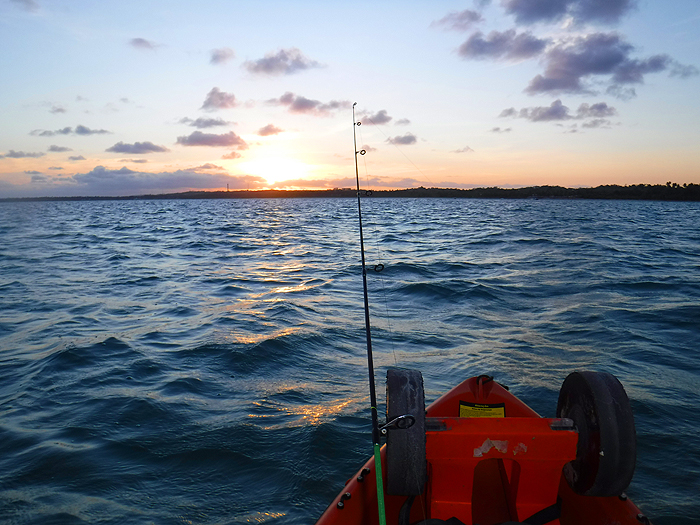
Anyway, I'd carry the bucket of gear and bait along with our two short rods with fixed spool reels armed with 20lb braid and 6/0-8/0 circle hooks on traces of either 40lb clear Amnesia or 26lb knottable wire. Richard, being, younger, fitter, stronger and more experienced, would haul the kayak down the street and out onto the beach before putting the wheels in the bow and towing it out through the surf. Since we were launching from wave pounded sandy beach we were limited to lowish tide and calmer conditions if we were to avoid being swamped from the word go. After ten minutes paddling out towards the reef - usually with the added interest of half-beaks jumping into the kayak on the way - we would anchor up, cast our baits downtide and wait for the action. The normal bait was half a big sardine with me using the heads and my son the tails (which he whipped on with a spot of bait elastic). As in all fishing there were nuisance bait stealers but they were surprisingly few and at least they kept us alert.
Half-beaks often jumped aboard as we paddled out. Amazing colours eh?

A whole sardine bait well chewed by ?
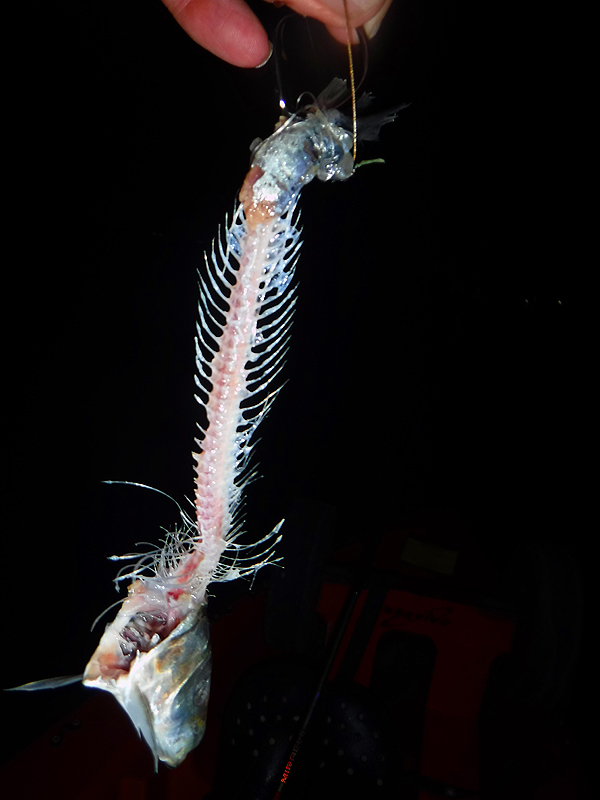
Using Google Earth Richard had chosen a gap in the reef as a likely spot for some action and we found that by lining up lamps on the shore we were able to locate our chosen mark even in the dark. On our first session we started fishing before nightfall simply to be sure where we placing our baits. The tides are fairly weak and so no lead was necessary to get the baits down in the two or three metres of water at high tide; the only variation was in the amount of swell/chop and subtle changes in wind direction. The big hooks tend to select for species with pretty large mouths so at times the baits were retrieved simply as skeletons after a bite that didn't 'develop'. Ideally takes would be in the form of a 'run' which could range from a slow, intermittent drag to a lightening snatch followed by the line whipping out at warp speed. We learned over time to distinguish some species from their behaviour. Morays (horrid) and silver catfish (unwanted) tended to 'slime' the trace, sting rays usually ran steadily and strongly and barracuda would often give a fast bite leaving us with either cut or damaged nylon traces (hence the wire that I favoured). It was interesting to speculate what was taking the bait but we were often wrong in our assumptions.
Silver catfish are small but pack a hefty sting - hence the grip.
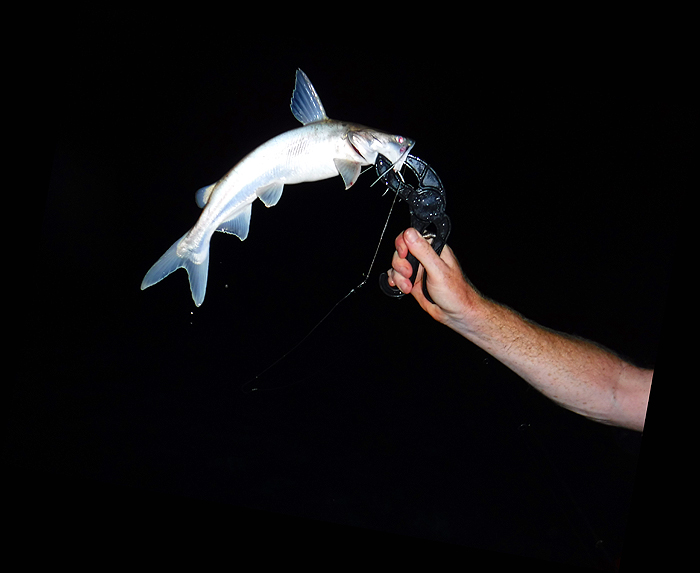
When free-lining with circle hooks it is vital - (a) Not to strike (b) Release a metre or two of slack before closing the bale and (c) To close the bale arm without a clunk to avoid dropped runs (just like bass fishing really). At first I was outfished by Richard's experience but unlike the shore fishing my son's physical advantages were less of a handicap for me and on the later trips I began to get the hang of it and I caught up in the friendly 'fish landed' competition.
Things didn't start well. On one of our our first exploratory sorties, which began in the daylight hours, we were horrified to find that a local fisherman had set his gill net right across our intended mark. He clearly had no intention of removing the net so we were forced to fish in rougher water downtide of the net. As we sat waiting for the first bite it became clear from the many splashes and heads popping up that there were turtles everywhere. This should have given us a clue when Richard's sardine was taken by a remora. We caught these fish on both lures and bait so clearly they leave the hosts to forage for both live prey and corpses.
A small remora, better than nothing!
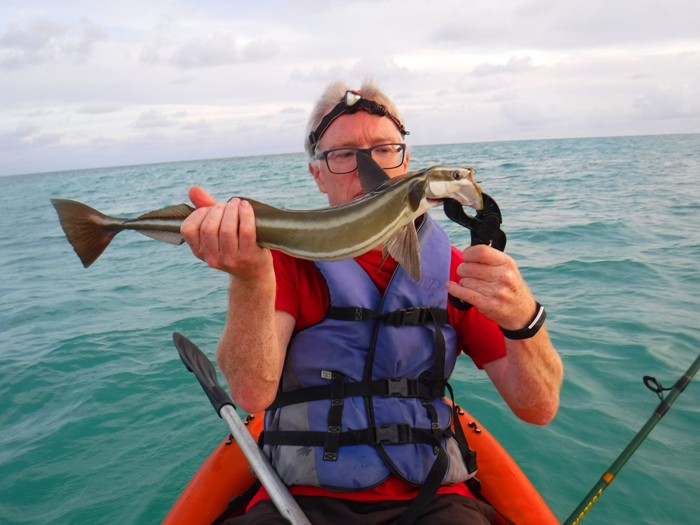
... and a bigger one
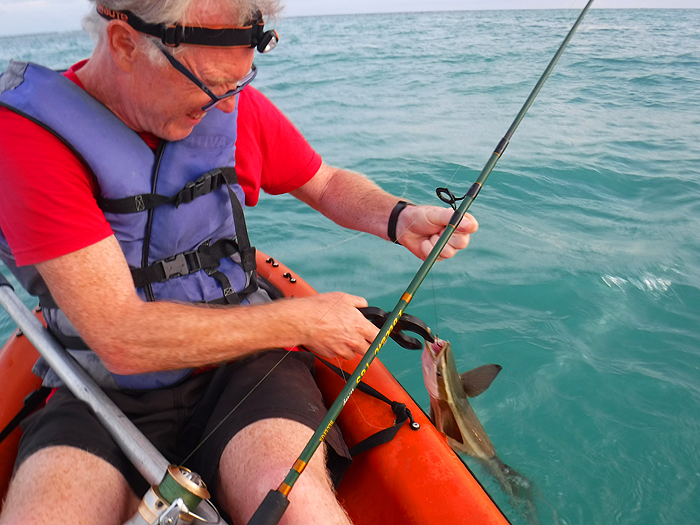
A large one in the morning, note the modified fin/ sucker for hitching lifts on turtles and fish.
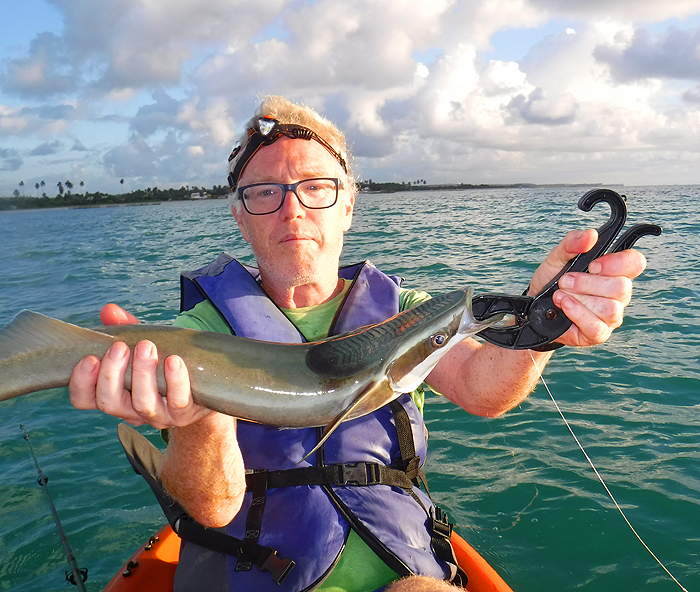
In the dark the biggest and most consistent catches were southern sting rays. The ones we caught averaged about seven kilos (15lb or so) in weight with the best ones twice as heavy. On the little rods and relatively light gear these fish put up strong resistance and a big one often took a good ten minutes to bring to the kayak. By turning them on their backs and using the gripper to hold them, they were generally unhooked and returned unharmed. It will be obvious that Richard, in the stern, handled all the fish (his and mine) while I tried to take pictures over my left shoulder. Both of these operations were tricky and on one trip Rich had his pliers flicked from his grasp (by a fish) into the depths and these were followed by the scissors as he tried to cut the trace. On later trips the implements will be securely attached to cords or lanyards.
A decent stingray comes flapping up to the kayak. Note the clump of turtle grass on the trace.
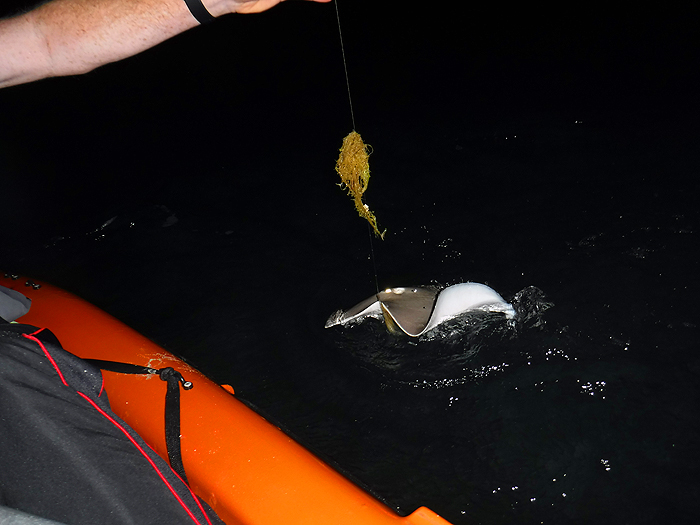
Ready to be turned over and unhooked.
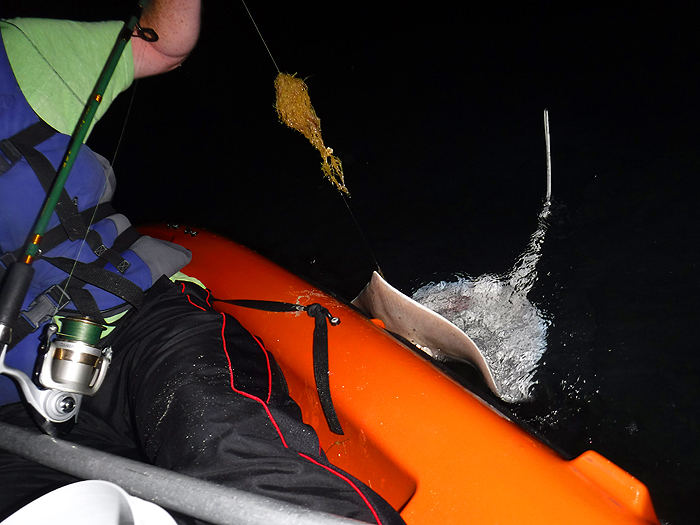
A larger ray at the boat and in position for the tricky operation of hook removal!
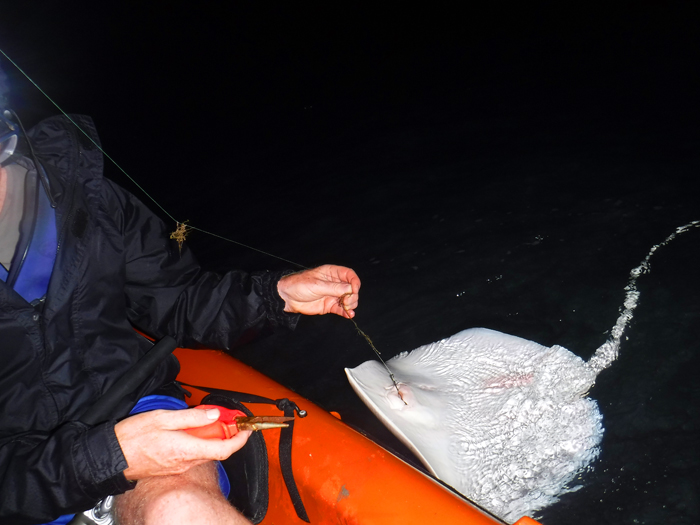
Although stingrays were the commonest large fish we caught a variety of species including gafftopsail catfish, sea catfish, mutton snapper and barracuda (not the 'great' barracuda but smaller species with equally vicious teeth). I had a speciment sea catfish of almost 5kg and a good sized mutton snapper which went home for dinner with us. The latter fish was the first of its kind that we have had from the kayak. We also caught a number of morays which are even more of a problem to unhook than our own freshwater eels or congers. Morays not only have a horrendous set of teeth but they are slimy and writhe back up the line as they are being landed - I didn't take any pictures of them. There are a number of species such as jacks, mackerel, leatherjackets, lookdowns and snappers which should be susceptible to lure fishing from the kayak but when we tried it (in the dark) they were not playing ball.
My big sea catfish ready to be unhooked.
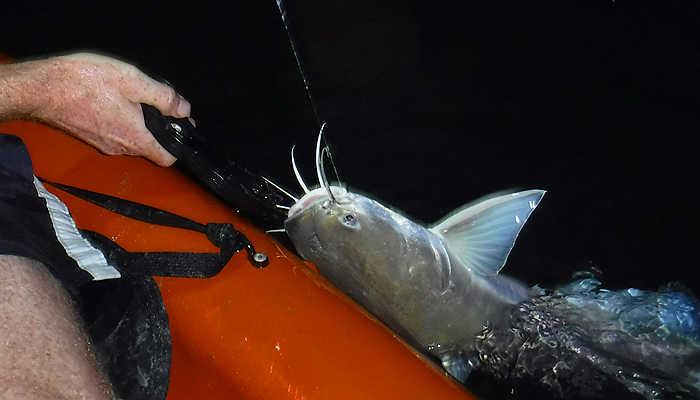
Richard displays the sea catfish.
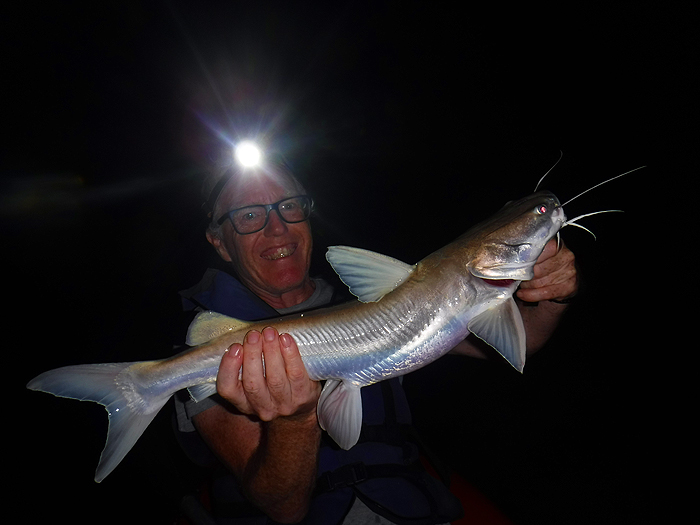
A small barracuda (guachanche).
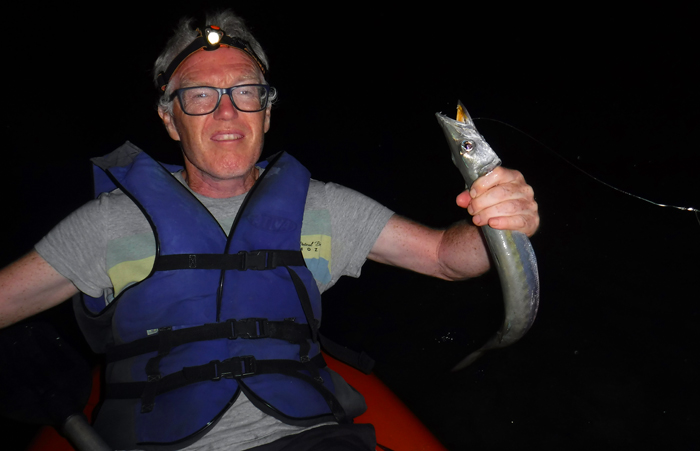
... a better one showing the needle sharp gnashers.
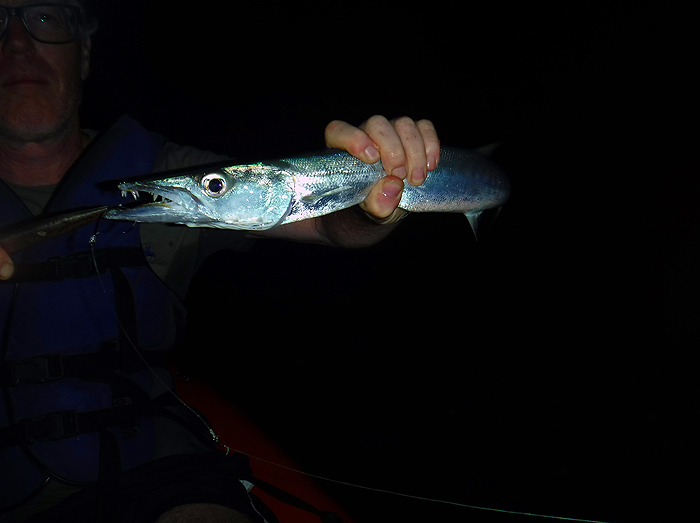
My mutton snapper which fed six of us that evening.
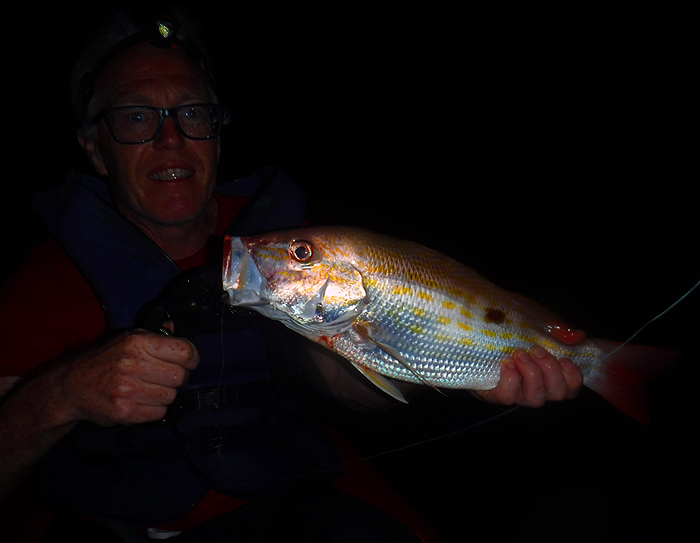
Overall, including a couple of blank sessions, the kayak fishing produced a decent fish for roughly every 'rod-hour' of effort. By any standards this is pretty good fishing and with experience it should get even better. I can't wait to try again. In the next page I'll say something about the mouth watering possibilty of other fish.
– PLEASE TELL YOUR TWITTER, FACEBOOK, EMAIL FRIENDS ABOUT THESE BOOKS.
NEW BOOK
"Fishing for Ghosts - Successful Mullet Angling"
written with David Rigden IT'S AVAILABLE FROM -ALSO THE NEW BOOK
“The Second Wave”
Written with Steve Pitts this is a SEQUEL TO THE BESTSELLER "Operation Sea Angler" IT'S AVAILABLE ON PAPER OR FOR YOUR KINDLE FROM -If you have any comments or questions about fish, methods, tactics or 'what have you!' get in touch with me by sending an E-MAIL to - docladle@hotmail.com